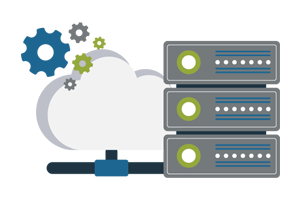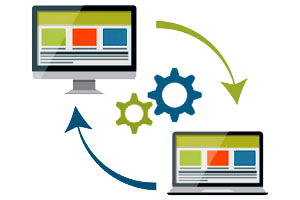Automation & Orchestration Enablement
The Foundation for Next-Generation Networking & Security Operations
Automation enablement represents a big change in how networks are securely built and managed. How big? As big as the invention of Ethernet switching had been more than three decades ago. Switching provided the foundation for today’s highly connected world, and automation & Orchestration enablement is the cornerstone for tomorrow’s networks.
Automation & Orchestration enablement means the “network guy” no longer needs to configure devices on an individual basis. Instead, the outcome is defined, and the systems do all the configuration work. This vastly reduces errors and speeds up deployments or changes to the network.
The same question should be asked about how a day in the life of a “security person” changes with these trends. As business environments adapt and change to accommodate increasing cloud applications, new security threats manifest more quickly than ever. Security Operations Center (SOC) administrators struggle to manage the influx of alerts generated by their monitoring and threat detection tools. As a part of the Security Orchestration Automation Response (SOAR) framework, automation enablement allows SOCs to automate specific low-level tasks that typically require a security analyst to resolve, freeing up critical time to spend on more plausible threats.


What is the difference between automation & orchestration?
Orchestration is the integrating of disparate security systems. This has been a primary focus of Cisco during the last several years. As an example, malware detected on a workstation (or by a mail server) would notify the firewall not to allow a file with this signature to pass. It might also move the workstation to an isolated VLAN for remediation. The coordination of these tasks across different security products would represent not just a time-saver, and it would improve mean time to repair or remediation.
What is Network Automation Enablement?
To understand automation enablement’s impact, we need to take a close look at today’s network deployments. They require a great deal of manual configuration. For example, if a company wants sales department personnel to access client data via their smartphones, a network technician manually configures those connections.
Such work is tedious and time-consuming because of the diversity found in computing infrastructure. Networks consist of wired and wireless connections, a central office and branch sites, local area networks, wide area networks (WAN), data center connections, and the cloud.
End-user devices span laptops, smartphones, tablets, and recently a number of devices connected to the Internet of Things (IoT). All of these connections must be made in a secure manner. As a result, businesses pay techies lots of money to complete that work. Recently, network devices have become smarter, offering companies the ability to automate the manual functions. Automation enablement is based on Intent-Based Networking. Here, a company defines a business intent, such as encrypting information as it moves from the user device to the server. An intelligent network works with IBN policies and makes changes automatically. No more manually configuring connections.


What is Security Automation Enablement?
Security automation is similar to network automation because it automates tasks that would normally require human intervention to complete. The primary difference between the two is that security automation is utilized in applications meant to monitor and administer security tasks.
The engineering skillset necessary to manage the security infrastructure of a business is in high-demand, and SOCs are looking for ways to maximize the talent they have while maintaining SLAs. Without the use of security automation, highly-skilled engineers are spending too much time trudging through generic tickets and monitoring alerts, often leaving actual security threats in the queue.
Security automation is one portion of the SOAR framework and works in conjunction with security orchestration efforts. Security orchestration brings disparate systems together, empowering the automation system to do more from a single platform.
How Does Your Firm Benefit from Automation Enablement?
The potential benefits are great. A company increases agility. Enterprises are no longer hamstrung by lengthy IT backlogs; they respond immediately to organizational needs.
Organizations manage network operations more effectively. The time spent on network design, testing, and troubleshooting is reduced. IT pros receive alerts on their iPhones, so they make needed changes immediately, no matter where they are.
Security is strengthened. Consistent security policies keep sensitive data safe, and micro-segmentation ensures containment of any potential threats.
Compliance improves. Manual configurations are prone to human error. Automation enablement automatically applies policies, reducing human error and potential compliance lapses. And built-in integrity verification ensures that policies aren’t contradicting each other.
Companies reduce downtime. Automation enablement understands the impact of changes made to the network. These sophisticated systems alert network operators to potential issues as they arise and even take steps that address issues proactively.


The Best Orchestration & Automation Enablement Tools
But to reap these benefits, businesses need the right solution. Cisco has created a handful of products that deliver leading-edge automation enablement capabilities. Cisco’s Digital Network Architecture (Cisco DNA) is an open, software-driven architecture that delivers automation enablement functionality.
Cisco Intent-Based Networking (IBN) is built using Cisco DNA to automate networking tasks across your entire network, from your main location to your branch sites. It uses a network controller to manage all network activity, allowing your network to function as one cohesive unit.
Cisco SecureX is an open-source platform that follows the SOAR framework for security administration. From one simple dashboard, SOC teams can monitor alerts, quickly take action and keep records of steps taken. Automated workflows and runbooks can be created to address and manage types of events, no matter when they occur. SecureX is Orchestrating remediation or corrective actions across different Cisco Security products today with the promise of many third parties participating in the future.
Find the Right Partner
Businesses need help understanding how to take advantage of these new capabilities. Acadia Technology Group is proud to be a Cisco Premier Partner, offering a full portfolio of solutions and services. Operating out of the New York Metro Area, the company has worked with many businesses to deploy cutting edge network, IoT, and security solutions. Acadia Technology Group helped financial, legal, retail, and theme parks businesses streamline processes, increase revenue, and improve customer service by deploying state-of-the-art network solutions.

Related Articles
5 Ways SOAR Improves Collaboration Within a SOC Team
One of the first steps toward creating an effective Security [...]
How Does Artificial Intelligence Power Intent-Based Networking?
With traditional networking, system administrators are deeply involved in every [...]
Automatically Documenting Network Activity with IBN
Network documentation is time-consuming, tedious and is often outdated [...]


